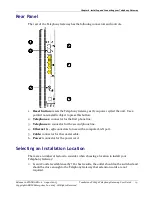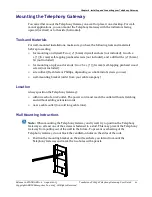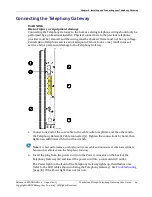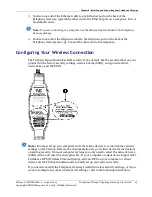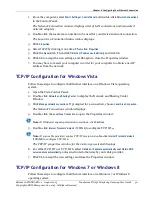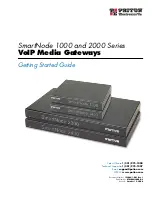
Chapter 3
:
Getting Started
Release 16 STANDARD 1.2 August 2015
Touchstone TG1652 Telephony Gateway User Guide
15
Copyright ARRIS Enterprises, Inc. 2015. All Rights Reserved.
Use the cable company’s mail servers for sending email.
Avoid using proxy software unless you are certain that it is not open for abuse by other
Internet users (some are shipped open by default). Criminals can take advantage of
open proxies to hide their identity when breaking into other computers or sending
spam. If you have an open proxy, your cable company may suspend your account to
protect the rest of the network.
The TG1652 ships with wireless LAN security set by default (for the same reasons that
you should run only secured proxies). See the security label on your product for the
factory security settings. If you need to modify the default wireless security settings, see
Configuring Your Wireless Connection.
Ethernet or Wireless?
There are two ways to connect your computer (or other equipment) to the Telephony
Gateway. The following will help you decide which is best for you:
Ethernet
Ethernet is a standard method of connecting two or more computers into a Local Area
Network (LAN). You can use the Ethernet connection if your computer has built-in
Ethernet hardware.
Note:
To connect more than four computers to the TG1652 through the Ethernet ports,
you need an Ethernet hub (available at computer retailers).
The Telephony Gateway package comes with one 4-foot (1.2m) Ethernet cable (the
connectors look like wide telephone connectors); you can purchase more cables if
necessary at a computer retailer. If you are connecting the Telephony Gateway directly to a
computer, or to an Ethernet hub with a cross-over switch, ask for Category 5e (CAT5e)
straight-through cable. CAT5e cable is required for gigabit Ethernet (Gig-E), not regular
CAT5 cable.
Wireless
Wireless access lets you connect additional (wireless-capable) devices to Telephony
Gateway. The 802.11 wireless LAN standard allows one or more computers to access the
TG1652 using a wireless (radio) signal. These connections are in addition to the
connections supported via Ethernet.



















